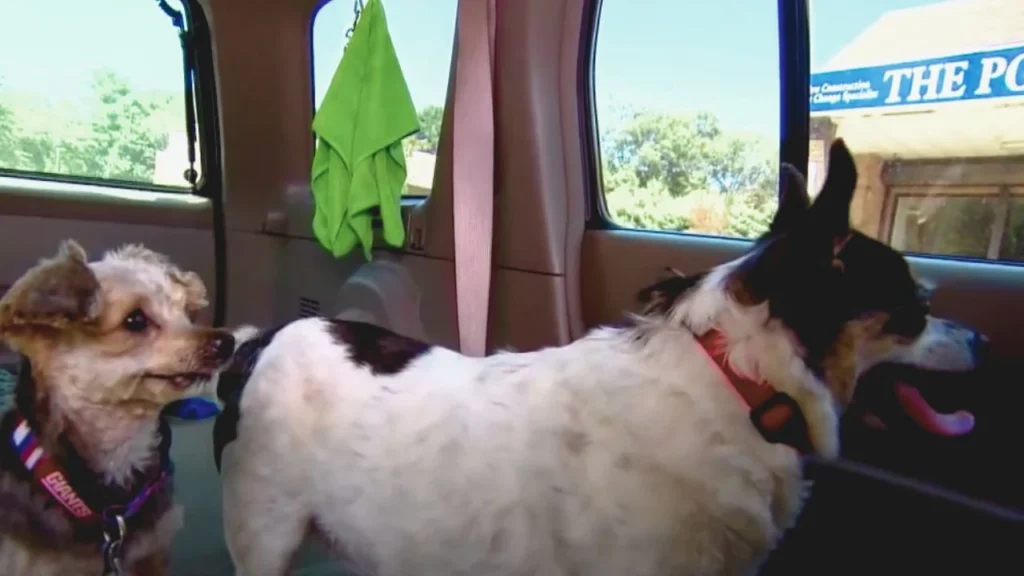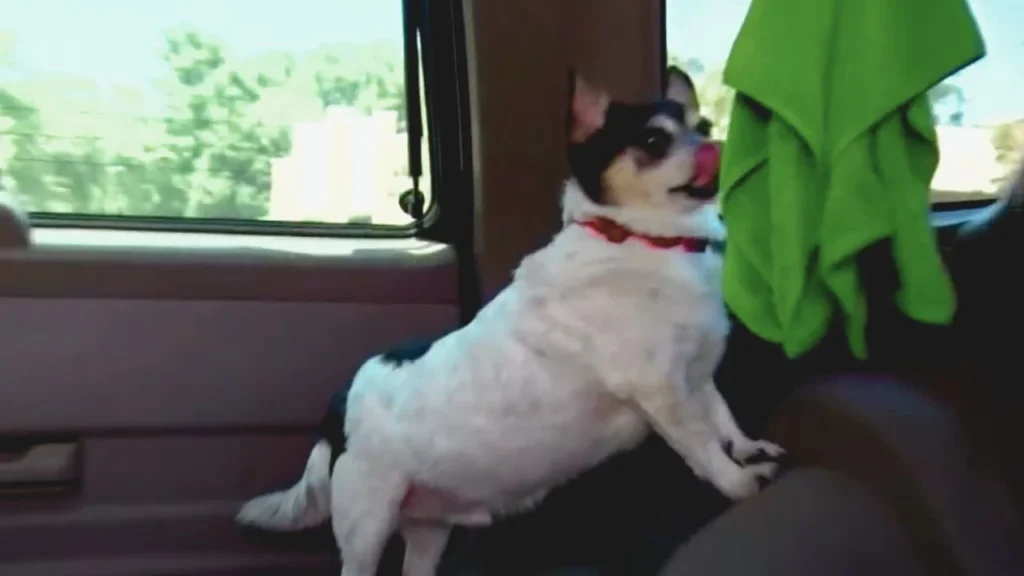When figuring out how to keep dog cool in car, it’s important to understand how quickly cars heat up. On a 75°F Day, the temperature inside a parked car can reach 100°F in just 10 minutes. Even cracking the windows doesn’t help much. Within 30 minutes, the car’s interior could rise over 120°F, putting your dog at risk of heatstroke.
Navigation Menu
How Dogs Handle Heat
Dogs aren’t like us. They can’t sweat much and rely on panting to cool down. A dog’s normal body temperature is around 101°F to 102.5°F. If it rises above 106°F, it can lead to heatstroke, organ failure, and even death.

Breeds like Bulldogs or Pugs are especially at risk due to their short snouts, while even healthier dogs can struggle in extreme temperatures.
The best way to keep your dog safe is by understanding these risks and taking quick action to prevent overheating.
Quick Fix
When learning how to keep dog cool in a car, it’s essential to know that temperatures can rise rapidly inside a parked vehicle. On a 75°F day, the temperature can reach 100°F within just 10 minutes, and cracking the windows may not help enough. After 30 minutes, the car’s interior could rise above 120°F, putting your dog at serious risk of heatstroke.
Dogs don’t cool down like humans. Their normal body temperature is 101°F to 102.5°F, and anything above 106°F can cause heatstroke or worse. Knowing these facts and following the right steps can help you keep your furry friend safe during your trips.
8 Expert Tips: How To Keep Dog Cool In Car
Tip 01: Pre-Cooling Strategies Before You Hit the Road
You don’t want to put your dog in a hot car and let them suffer while you wait for the air conditioning to kick in. Start cooling your car 5-10 minutes before your dog gets in. This simple step can reduce the inside temperature significantly.

Tips for Pre-Cooling:
- Run the AC early: Always blast the air conditioning before putting your dog in the car.
- Use portable fans: Battery-operated fans can help keep air circulating, especially if you need to turn off the car for a bit.
- Reflective window shades: These can help block out the sun and keep your car cooler for longer.
Tip 02: Must-Have Tools for Keeping Your Dog Cool
Here are some must-have items every pet owner should consider.
Cooling Tools:
- Portable Air Conditioners: Devices like IcyBreeze can reduce the car’s temperature by up to 35°F. They are battery-powered and perfect for cars.
- Cooling Pads and Vests: These are great for keeping your dog cool on long trips. Some cooling pads can last 4-6 hours before needing a recharge.
- Temperature Monitors: Use wireless monitors that alert you if the car gets too hot. This is a must-have if you ever need to leave your dog unattended for a short period.
Tip 03: Hydration Hacks for Keeping Your Dog Cool
Keeping your dog hydrated is critical for their comfort and safety. When focusing on how to keep a dog cool in a car, water plays a big role.

Hydration Tips:
- Collapsible Water Bowls: These are easy to carry and perfect for road trips.
- Frozen Water Bottles: You can freeze water bottles and place them in the car for a quick cooling effect. As the ice melts, your dog will have cool water to drink.
- Electrolyte Solutions: Dogs, like people, benefit from electrolytes to stay hydrated. Consider mixing dog-safe electrolyte solutions into their water for extra hydration.
Tip 04: Strategic Parking and Ventilation Techniques
Where you park and how you manage air circulation are critical. The right techniques can make a huge difference in the temperature inside your vehicle.

Parking and Ventilation Tips:
- Always park in the shade: This may seem obvious, but shade can keep your car 10-20°F cooler than direct sunlight.
- Use tailgate locks: These allow you to keep the back open slightly for ventilation without risking your dog jumping out.
- Window guards: These let you crack the windows safely, ensuring proper airflow while keeping your pet safe inside.
Tip 05: Dog Cooling First Aid (In Case of Emergencies)
Even with precautions, overheating can happen. Knowing how to keep a dog cool in a car also means being prepared for emergencies.
Emergency Cooling Steps:
- Recognize heatstroke symptoms: Signs include excessive panting, drooling, and weakness. If your dog’s body temperature reaches over 106°F, it’s critical to act fast.
- Immediate actions: Move your dog to a cool area, offer water, and apply cool (not cold) water to their paws and belly.
- Cooling towels: Always keep a cooling towel in your car. Soak it in water and place it on your dog’s body to lower their temperature quickly.
Tip 06: Time Limits for Leaving Dogs in Cars
It’s important to know there’s no safe time limit for leaving your dog alone, even with cooling tools in place. Car temperatures can rise fast, even if you’ve taken steps to cool the car.
Safe Time Limits:
- 5-10 minutes max: Even with all the right tools and techniques, don’t leave your dog in a car for longer than 5-10 minutes, especially in warm weather.
- Temperature monitoring: Use a wireless temperature monitor that alerts you if the temperature inside the car gets too hot.
Tip 07: Safety Laws and Best Practices
Knowing the legalities around leaving your dog in the car is a crucial part of understanding to keep a dog cool in a car.
State Laws on Dogs in Cars:
- State-specific laws: In states like California, it’s illegal to leave a dog in the car on very hot or cold days. Fines range from $100 to $500 depending on the severity.
- Rescue laws: In some states, it’s legal for bystanders to break your car window if they see a dog in distress. Always leave a note or visible sign showing that your dog is safe with a cooling system in place.
Tip 08: Specialized Advice for Different Situations
Depending on the circumstances, the way you approach how to keep dog cool in car may differ.
Truck Drivers and Long Haul Travelers:
- Portable AC: Truck drivers should invest in a battery-operated AC unit since idling laws may prevent you from running the truck’s air conditioning.
Multiple Dogs:
- Multiple cooling pads: If you’re traveling with more than one dog, ensure you have separate cooling pads or vests to manage the extra heat generated by multiple pets.
Older Dogs and Special Needs Dogs:
- Special care for senior dogs: Older dogs, especially those with respiratory issues, need extra cooling care. Consider frequent hydration breaks and use of cooling towels.
Keeping your dog safe during car rides requires a bit of preparation, but it’s worth the peace of mind.
Recognizing Signs of Heatstroke in Dogs
Heatstroke can become life-threatening within minutes. Watch for symptoms like:
- Excessive panting and drooling
- Disorientation or lack of coordination
- Bright red gums
- Vomiting or diarrhea
- Rapid heartbeat or breathing
- Lethargy or unconsciousness
If your dog shows any of these signs, act fast: move them to a shaded area, cool them with water (but not ice), and call your vet immediately.
Conclusion
Keeping your dog cool and safe in a car is crucial, especially during warmer months. By following the tips on how to keep dog cool in car, such as pre-cooling the vehicle, using the right tools like portable air conditioners and cooling pads, ensuring proper hydration, and knowing time limits, you can significantly reduce the risk of heatstroke or overheating. Remember, even with all precautions, it’s always better to err on the side of caution. If you don’t absolutely need to leave your dog in the car, it’s best not to. Your dog’s safety should always come first!
FAQs
1. How long can a dog stay in a cool car safely?
Even with cooling devices in place, it’s recommended not to leave your dog alone for more than 5-10 minutes. Car temperatures can rise quickly, and despite cooling measures, it’s not worth the risk.
2. What temperature is too hot for a dog in a car?
When the outside temperature hits 70°F or higher, the inside of your car can become dangerous for your dog within minutes. Dogs start to overheat when their body temperature goes above 103°F, and anything above 106°F can lead to heatstroke.
3. Is it safe to leave the windows cracked open for ventilation?
Cracking the windows only slightly helps with air circulation, but it does not keep the car cool enough. A car’s interior can still reach dangerous temperatures even with the windows cracked open.

